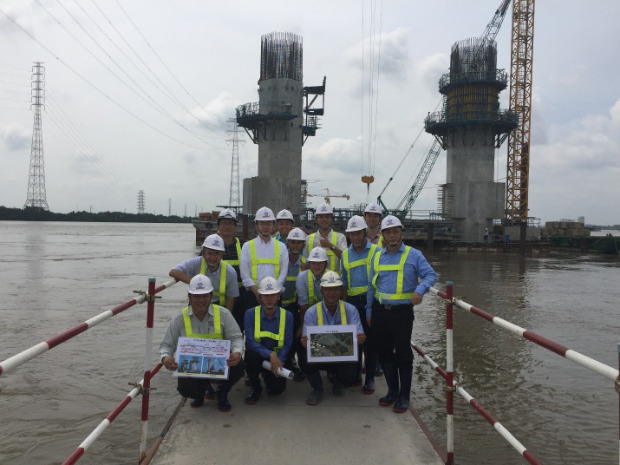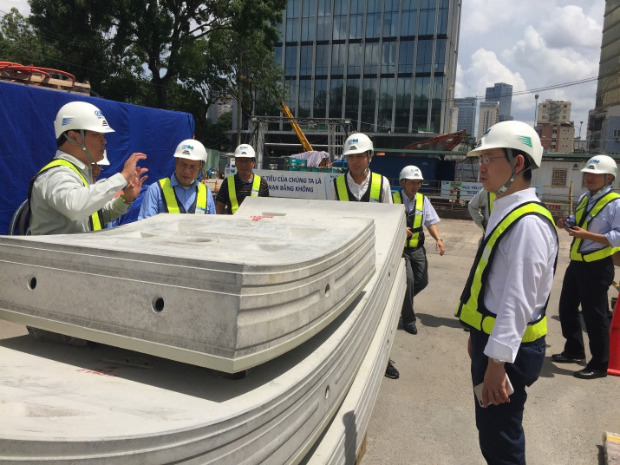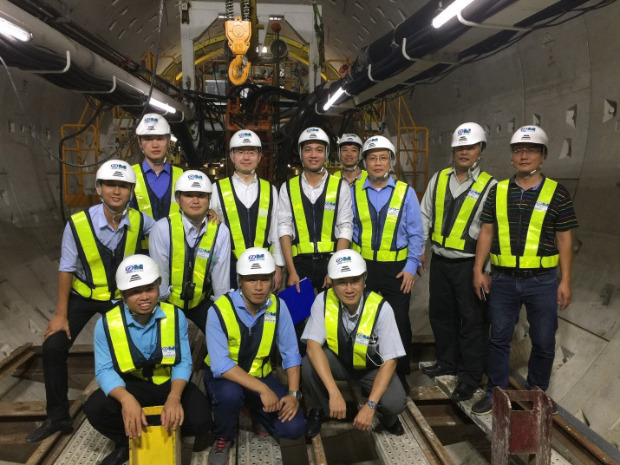On June 18 – 19, 2017, Prof. Nguyen Dinh Duc, Program Director, Prof. Dr. Hironori Kato (University of Tokyo) – Program Co-Director, Dr. Phan Le Binh (JICA) and 1st cohort students majoring in Infrastructure Engineering, Vietnam Japan University (VJU-VNUHN) visited three construction works in Ho Chi Minh City, financed by Japan’s ODA.
The main purpose of the visit is to give the students hands-on experience and direct observation on the construction site, while facilitating and expanding the partnership between VJU and Japanese construction companies operating in Vietnam.
The first destination is the construction site of Binh Khanh Bridge. This is the post-tensioned concrete cable-stayed bridge with a maximum span of 375m, only second to Bai Chay bridge. The foundation of the cable-stayed pillar is made of steel sheet pile wall, an advanced technology developed by Japan and applied in many bridge construction projects in many countries around the world.

Photo: VJU delegation at Binh Khanh bridge construction site
Steel pipes (also called steel pipe piles) have a diameter of about 1.5 meters, thickness of 15-18mm, which are buried deep into the ground until they reach aload bearing layer at a depth of 40-60m. The steel pipes are firmly joined together to form a diaphragm, which blocks the river and forms a gigantic space about two times the size of a tennis court for constructing the bridge piers. This advanced technology substantially reduces construction time compared to the conventional plank walling technology while reducing the cross section of the construction well, with minimal effect on the flow of the river. This technology has also been applied to other bridges in Vietnam such as Binh Bridge, Bai Chay Bridge, Nhat Tan Bridge, etc.
The next destination of the VJU delegation is Metro Tunnel No.1 of Ho Chi Minh City. This is a great project, stretching nearly 20 km from Ben Thanh to Suoi Tien, passing through districts 1, 2, 9, Binh Thanh, Thu Duc (HCMC) and Di An district (Binh Duong province), with total investment mounting up to over USD 2.4 billion.

Photo: VJU delegation at Metro Tunnel No.1 of Ho Chi Minh City.
The tunnel section is constructed with a shielding technology, which uses huge “drill bits” of about 7 meters in the case of underground tunneling and about 16 meters for road tunnels. The important difference from the excavation method is that it minimizes pavement occupation associated with tunneling, thereby minimizing traffic congestion during construction in urban areas. At the same time, it also keeps noise and dust in the surrounding area to the minimum. This method is especially suitable in case of tunneling in locations with great depths where open excavation is impossible. During drilling process, high-pressure concrete slabs will be concurrently installed to form Metro tunnel. This helps to withstand soil and ground water pressure, minimize the potential for subsidence of adjacent buildings, and the concrete walls are also used to support the plunger to propel the drill up the next tunnel section. This advanced technology reduces manpower, enhances safety, and increases productivity. By June 19, 2017, the first 12 meters of Metro tunnel have been constructed using this technology, out of 2.4 km to be constructed, the remaining section will be on the surface).

Photo: The VJU delegation in the first Metro tunnel of Ho Chi Minh City.
Lastly, the delegation visited the water environment improvement works of Ho Chi Minh City.
The project employs pipe drilling technology to be applied when constructing underground water supply or sewer pipes in urban areas, with smaller but more diversified pipes compared to traffic tunnels. The diameter of the “drill” can be 30cm, 50cm, 120cm or 180cm. What distinguishes it from Metro tunnel drilling technology is that after drilling deep into the ground, 2.5 m long piping is pushed forward to form a continuous pipeline. In addition to drilling technology, advanced geodetic technology is also used here to help navigate the drilling direction, which allows waves, not just drilling in straight lines. This technology also saves construction time, minimizes road surface occupation, and thus traffic congestion compared to open excavation, and can be applied at depths of 5-6m or more, with minimal impact on other existing underground works in the city such as electricity, telephone, water, etc.
The field trip is part of a series of activities aimed at high quality human resource training of VJU. In an effort to continually incorporate local business enterprise experience through fieldwork, field trips, and a wide variety of thematic seminars with guest speakers and experienced professionals, VJU tries to facilitate students’ access to extra curriculum and industry-based experience.

